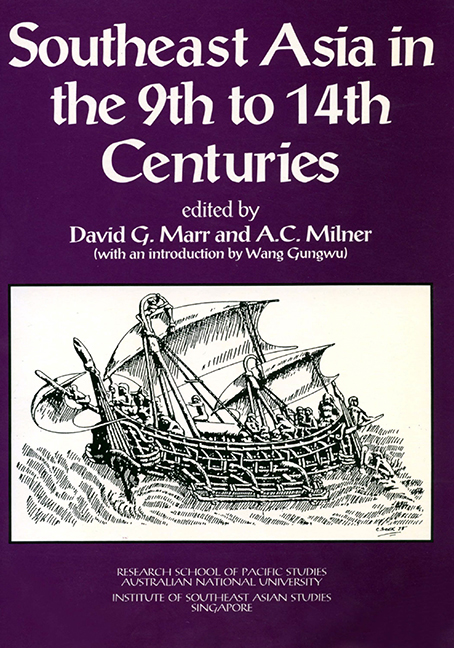Book contents
- Frontmatter
- Contents
- Contributors
- Preface
- Introduction
- 1 The Early and the Imperial Kingdom in Southeast Asian History
- 2 Hydraulic Works and South East Asian Polities
- 3 Some Notes on Relations between Central and Local Government in Ancient Java
- 4 Negara, Mandala, and Despotic State: Images of Early Java
- 5 Some Remarks on Early State Formation in Cambodia
- 6 “Elephants Can Actually Swim”: Contemporary Chinese Views of Late Ly Dai Viet
- 7 Authority and Legitimacy in 11th Century Vietnam
- 8 From Myth to History: Imagined Polities in 14th Century Vietnam
- 9 Shipshape Societies: Boat Symbolism and Political Systems in Insular Southeast Asia
- 10 Changing Perspectives in Island Southeast Asia
- 11 Political and Cultural Continuities at Dvaravati Sites
- 12 The True and the Corbel Arch in Mainland Southeast Asian Monumental Architecture
- 13 Vietnamese Ceramics and Cultural Identity: Evidence from the Ly and Tran Dynasties
- 14 Traditions, Acculturation, Renovation: The Evolutional Pattern of Vietnamese Culture
- 15 Symbolism of Kingship in Arakan
- 16 Buddhism in Champa
- 17 The Ordering of Generations: Change and Continuity in Old Javanese Kinship
- 18 Sources on Economic Activities in Khmer and Cham Lands
- 19 Narrative Bas-Reliefs at Candi Surawana
- 20 Possibilities for a Reading of the 1293-1357 Period in the Vietnamese Annals
- Index
- Miscellaneous Endmatter
16 - Buddhism in Champa
Published online by Cambridge University Press: 21 October 2015
- Frontmatter
- Contents
- Contributors
- Preface
- Introduction
- 1 The Early and the Imperial Kingdom in Southeast Asian History
- 2 Hydraulic Works and South East Asian Polities
- 3 Some Notes on Relations between Central and Local Government in Ancient Java
- 4 Negara, Mandala, and Despotic State: Images of Early Java
- 5 Some Remarks on Early State Formation in Cambodia
- 6 “Elephants Can Actually Swim”: Contemporary Chinese Views of Late Ly Dai Viet
- 7 Authority and Legitimacy in 11th Century Vietnam
- 8 From Myth to History: Imagined Polities in 14th Century Vietnam
- 9 Shipshape Societies: Boat Symbolism and Political Systems in Insular Southeast Asia
- 10 Changing Perspectives in Island Southeast Asia
- 11 Political and Cultural Continuities at Dvaravati Sites
- 12 The True and the Corbel Arch in Mainland Southeast Asian Monumental Architecture
- 13 Vietnamese Ceramics and Cultural Identity: Evidence from the Ly and Tran Dynasties
- 14 Traditions, Acculturation, Renovation: The Evolutional Pattern of Vietnamese Culture
- 15 Symbolism of Kingship in Arakan
- 16 Buddhism in Champa
- 17 The Ordering of Generations: Change and Continuity in Old Javanese Kinship
- 18 Sources on Economic Activities in Khmer and Cham Lands
- 19 Narrative Bas-Reliefs at Candi Surawana
- 20 Possibilities for a Reading of the 1293-1357 Period in the Vietnamese Annals
- Index
- Miscellaneous Endmatter
Summary
One of the most often-met ideas in the history of “Indianized” South-East Asia is that of “adaptation” to the genius of local or “indigenous” cultures. It is impossible to turn many printed pages on the subject without coming across an appeal to this notion of cultural adaptation as an explanation of the change suffered by some rite, cult, doctrine, style, science or institution from one place to another.
So far as it goes, this is all to the good. Local South-East Asian cultures are not mere characterless departments of monolithic and undifferentiated civilizations with their hearts in Benares, or Bodhgaya, or Mecca, or Changan. On the contrary, it often happens, as O.W. Wolters has recently pointed out with finesse, that imported cultural elements “retreat” into the native soil of the host civilizations.[1] Champa offers good examples of the process. One need look no further than Paul Mus' paper on India and Champa: Hindu divinities have melted into, fused with, the stelae called kut which distil local magic forces. The god Indra is misremembered by latter-day Chams as the folk hero Yan In.[2] But there is still a dimension missing, and, until it is supplied, the cultural history of the region will remain, at best, incomplete.
What is already well recognized is the way in which different societies may differ from each other, each tempting us to treat it as an undifferentiated “personality” for the purpose of contrasting it with others. The missing dimension, on the other hand, is the one that spans the range of cultural activities within a single society.
To understand this dimension, we must distinguish between the raw material of “culture” and the types of activities which embody and express it. To put the matter at its simplest, a single cultural motif or idea may be embodied in one activity in one society and in another activity in another society. The difference in activity does not of itself constitute a difference in style and personality between the two societies. They may have much the same range of activities.
In the mouth of the Buddha, we might say, Buddhism was a soteriological activity. Under Aśoka, it was political: it served to legitimize an emperor's programme. In eighth century Bengal, it furnished tantric magic practices.
- Type
- Chapter
- Information
- Southeast Asia in the 9th to 14th Centuries , pp. 289 - 314Publisher: ISEAS–Yusof Ishak InstitutePrint publication year: 1986



